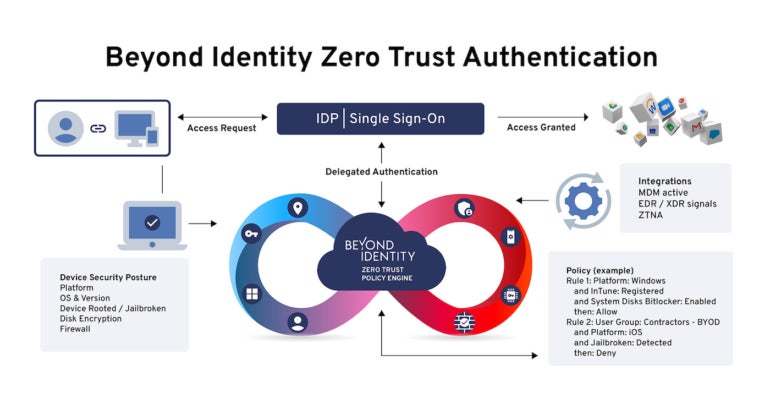[ad_1]

Credential security company Beyond Identity has launched the Zero Trust Authentication initiative for organizations to hack-proof user credentials, with backing from major firms.
Zero trust is a framework that secures infrastructure and data, in part by eliminating arbitrary perimeter and demanding authentication from all users and endpoints inside and out. It includes, therefore, credentials.
In an effort to codify just how IT should apply that in practice, companies including Zero Scaler, Optiv, Palo Alto Networks, Crowdstrike and Ping Identity are supporting an initiative led by security firm Beyond Identity to lay out a zero trust architecture to inoculate corporate accounts and credentials against phishing and ransomware, among other threats.
The company held a virtual kickoff on March 15, 2023 in New York to announce the program, which aims to address weak links in security, passwords and MFA that can allow attacks such as that which led to the hacking of a LastPass engineer’s corporate laptop in 2022.
SEE: Mobile Device Security Policy (TechRepublic Premium)
“Fundamentally, we are talking about authentication, but authentication that rises to the zero trust level,” said Patrick McBride, chief marketing officer at Beyond Identity. “Because so many auth protocols out there are easily bypassed — not even a speed bump.”
Jump to:
Passwordless, phishing free protocols among ZTA measures
The company laid out a set of measures organizations can implement to bolster defenses and insulate endpoints from lateral movement:
- Passwordless – No use of passwords or other shared secrets, as these can easily be obtained from users, captured on networks, or hacked from databases.
- Phishing resistant – No opportunity to obtain codes, magic links, or other authentication factors through phishing, adversary-in-the-middle, or other attacks.
- Capable of validating user devices – Able to ensure that requesting devices are bound to a user and authorized to access information assets and applications.
- Capable of assessing device security posture – Able to determine whether devices comply with security policies by checking that appropriate security settings are enabled, and security software is actively running.
- Capable of analyzing many types of risk signals – Able to ingest and analyze data from endpoints and security and IT management tools.
- Continuous risk assessment – Able to evaluate risk throughout a session rather than relying on one-time authentication.
- Integrated with the security infrastructure – Integrating with a variety of tools in the security infrastructure to improve risk detection, accelerate responses to suspicious behaviors, and improve audit and compliance reporting.
How to achieve high security credentials
McBride said that to establish high trust in the user identity, a passwordless, phishing resistant MFA is critical, e.g., a FIDO2 passkey: a FIDO2 passkey.
Based on FIDO authentication standards and using asymmetric public/private pairs, FIDO2 login credentials are unique for each web site, and, like biometric passkeys, never leave a user’s device and are never stored on a server “That also gives phishing resistance. I’m not sending anything over the network that is usable by a bad guy,” McBride added (Figure A).
Figure A

Chris Cummings, VP product and solutions at Beyond Identity explained that continuous monitoring is critical to security. He said Beyond Identity’s policy engine takes signals in and sends instructions out either to authenticate or not authenticate to the single sign-on Okta, or to take action on a specific device (for example, quarantine it until the user or IT can inspect it).
“That notion of continuity stems from Palo Alto Networks,” he said. “They really emphasize continuous and the reason why they work with us is because we provide continuous verification — one of the seven elements of Zero Trust Authentication — and they do that for application access.
A key aspect of implementation is ease of use — removing time-consuming tasks for the valid endpoint device user, noted McBride.
He explained end users want to be able to access their devices quickly, and that forcing users though cumbersome, high-friction security methods often prompts users to switch them off entirely. “We think you can have your cake and eat it too: High security with low friction,” said McBride.
Moving beyond passwords and MFA
According to McBride, the ZTA principles will help organizations move beyond the limitations of passwords and multi-factor authentication. “Auth methods aren’t working. Passwords are fundamentally flawed, so if you store them or transit over networks they get stolen, and every 75% to 80% of initial access comes from these issues,” he said.
The ZTA protocols include risk scoring and what the company refers to as continuous authentication capabilities — authentication decisions that are risk based and updated, based on data from cybersecurity tools for an ‘always-on’ zero trust world, per the company.
SEE: 1Password is looking to a password-free future. Here’s why (TechRepublic)
Threats in the wild: Multiple attack vectors through valid accounts
The Mitre ATT&K framework keeps a log of cyber threat actors and techniques. Among them are 17 credential access techniques used to obtain and abuse credentials of existing accounts to gain access, persist within a system, escalate privilege and so on. The organization notes that credentials can even be used to access remote systems and external services including VPNs, Outlook Web Access, network devices, and remote desktops.
A brief sample of the more than 40 threat groups that Mitre reports have exploited valid accounts over the past decade and a half includes:
- APT18: Leverages legitimate credentials to log into external remote services to target technology, manufacturing, human rights groups, government and medical industries.
- Axiom: Suspected Chinese cyber espionage group that used previously compromised administrative accounts to escalate privileges.
- Spider Wizard: a Russia state actor using valid credentials for privileged accounts with the goal of accessing domain controllers.
- Polonium: A Lebanon-based group has primarily targeted Israeli organizations, including critical manufacturing, information technology, and defense industry companies using valid compromised credentials.
“For attackers, the initial vector of choice is valid accounts,” said McBride. “Sophisticated actors use this all the time and there is an arms length list of bad actors using them, and they use them because they constitute the ‘easy button.’ They don’t want to burn a zero day, or use a really sophisticated method if there’s an easy button to use.”
He added that phishing, contrary to popular opinion, is the second most common way to deploy ransomware. Number one is logging in using stolen credentials to gain remote access to software, desktop or servers. “Weak authentication has real world consequences,” he said.
“Year after year, identity and authentication vulnerabilities remain the single largest source of ransomware and security breaches, so something has to fundamentally change to close this vulnerability and enable organizations to meet the security mandates issued by the White House, NIST and CISA,” said Chase Cunningham, chief strategy officer at Ericom Software, who is backing the initiative, in a statement.
Jay Bretzmann, research VP at IDC, added: “Delivering continuous verification of identity — user and devices — is essential to meeting the promise of zero trust.. Beyond Identity has taken the approach to utilize signals from security infrastructure in near real-time to raise the security standard and capitalize on existing security infrastructure investments in EDR and SASE tools.”
[ad_2]
Source link



